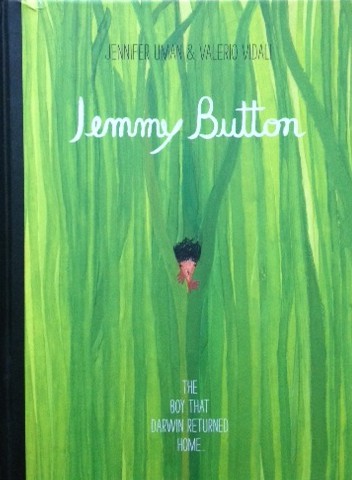Inspiring Young Readers
 posted on 23 Dec 2017
posted on 23 Dec 2017
Jemmy Button by Jennifer Uman & Valerio Vidali
Told with the minimum amount of words, this book is an unusual collaboration between two illustrators who met online. Although one speaks only English and the other Italian, they found ways of overcoming this problem over a two year period and this superb book is the product of the relationship.
Jemmy Button tells the true story of a young boy called Orundellico who lived in the islands of Tierra Del Fuego, a dependency of Chile, who was bought from his parents in the early years of the 19th century by Robert Fitzroy, captain of The Beagle. Orundellico was taken from his parents in exchange for a button made of mother-of-pearl – hence his nickname, Jemmy Button – and taken to England to be educated.

Fitzroy really wanted the boy as an experiment – he was convinced that it should be possible to ‘civilise a savage’ by exposing them to Christianity and upper-class manners. As was often the case with people taken from their homes to be exotic souvenirs, Orundellico in the guise of Jemmy Button became a short-term sensation and briefly found himself at the centre of polite society – even the king and queen at the time, William IV and Adelaide, asked to meet him.

Then in 1832 Fitzroy decided it was time to return Jemmy to his home islands and they set sail accompanied by Charles Darwin who wanted to see how Orundellico would readapt to his native land. Fitzroy believed that the years of time spent in England would lead Jemmy to spread the values of civilisation to his fellow natives – but that’s not at all what happened.
Back home again Orundellico quickly returned to his native state and, with great effort, relearned his language.


The power of the story doesn’t really need the message to be spelt out and these two illustrators have worked together superbly, blended their skills and produced a stunning and cohesive picture book. It’s not too difficult to see the different styles at work but they never clash or jar. The large format and minimal text give maximum space for the drawings to work their magic – bold colours, the use of silhouette and what look to me like woodblock printing techniques all make for arresting and dramatic drawings.

There’s also a nice bit of detail on the front cover which is textured to replicate the tall standing foliage that the young Orundellico is peeping out of. Running your hand across the cover gives you a real sense of how real books can provide a sensory as well as an aesthetic or intellectual thrill.
Copies are readily available for well under £10. The paperback is a little cheaper than the hardback but it’s negligible and so you should certainly choose the hardcover version.
Terry Potter
December 2017
